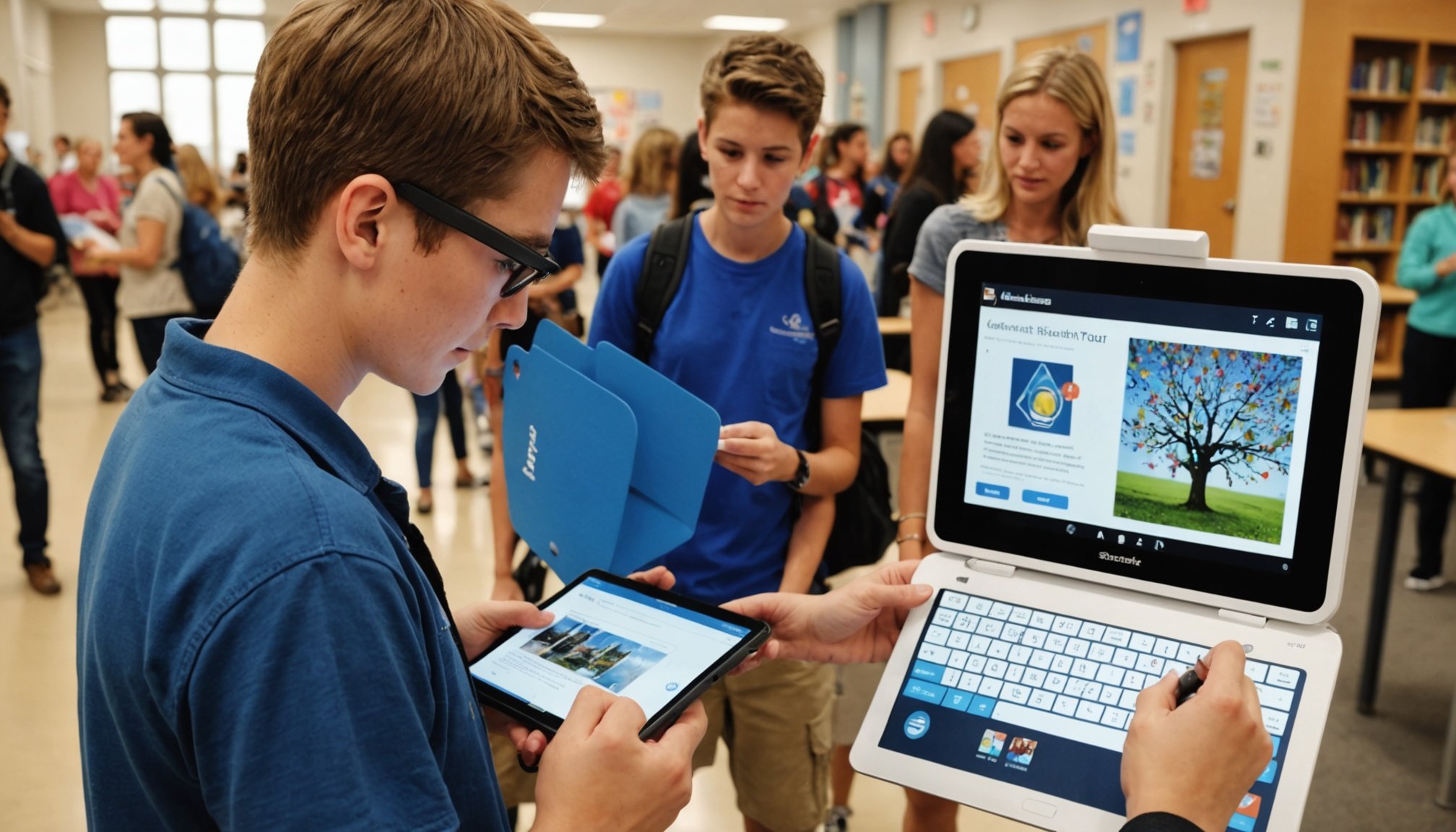Overview of Augmented Reality in Education
Augmented Reality (AR) is transforming educational settings, offering immersive learning experiences that merge digital data with the real world. This innovation in educational technology enhances traditional teaching methods by overlaying digital content in a physical environment, thus enriching how students interact with educational materials.
Current trends highlight a significant shift towards augmented reality applications, such as interactive simulations and virtual labs. These tools enable learners to engage with concepts that are often abstract or difficult to visualize. For instance, medical students now explore the human body in 3D without needing actual specimens, providing a safer and more ethical learning environment.
Also to read : Key components for designing an intuitive inventory system in complex rpgs
The integration of AR in educational technology promotes numerous benefits, including increased engagement and motivation among students. This is achieved by making challenging subjects more accessible and enjoyable. Additionally, AR serves as an essential teacher resource, offering educators new strategies to cater to diverse learning styles. By providing visual and interactive content, teachers can better illustrate complex topics and assess students’ understanding in real-time.
To harness these advantages, schools are increasingly investing in AR-enabled tools and curricula, aligning with progressive educational paradigms. Augmented Reality thus stands as a pivotal element in the evolution of educational experiences, preparing students for a tech-driven future.
In the same genre : Mastering the maze: key hurdles in developing cross-platform multiplayer games
Planning AR-Enhanced Scavenger Hunts
Designing a Scavenger Hunt with augmented reality (AR) can transform standard Educational Activities into an immersive learning experience. Here is a concise guide to help educators weave these experiences into their Lesson Planning effectively.
Steps to Design an Effective Educational Scavenger Hunt with AR
Start by determining the scavenger hunt’s educational goals. Defining clear learning outcomes is crucial. Then, identify the real-world locations where participants will engage with the game. Consider outdoor venues, museums, or even school corridors. It’s essential to ensure these locales are safe and accessible to all participants.
After choosing the locales, incorporate AR elements that align with the learning objectives. These could include interactive quizzes, virtual objects, or geographical markers that appear when users point their devices in certain directions.
Considerations for Location, Activities, and Learning Outcomes
Align the activities within the Scavenger Hunts with the overall educational curriculum standards. This ensures the experience reinforces classroom teachings. Additionally, consider the technology’s accessibility to students and the logistical aspects of hosting multiple learners in specific locations. Testing the AR setup ahead of time can prevent unexpected disruptions.
Overall, planning Educational Activities with AR involves a harmonious blend of exciting technology and structured Lesson Planning. This approach encourages deeper engagement and practical understanding of educational content.
Tools and Apps for Augmented Reality Integration
Integrating AR applications into educational settings can transform the classroom experience by making learning more interactive and engaging. Popular AR applications specially suited for educational scavenger hunts include Quiver, Google Expeditions, and HP Reveal, which offer unique features tailored to teaching environments.
Quiver allows students to colour printouts and then see their artwork come to life through AR, promoting creativity and understanding of the subject matter. Google Expeditions provides immersive virtual field trips, enabling students to explore new places and ideas without leaving the classroom. HP Reveal is an intuitive tool enabling teachers to create AR experiences by linking videos and interactive content to real-world images.
When selecting AR tools for a classroom, consider features such as ease of use, compatibility with devices, and the capacity for interactive learning. Tools should cater to both educators and students, offering intuitive interfaces and robust content libraries.
In a classroom setting, AR tools can be used to create dynamic lessons. For instance, students can participate in AR-based scavenger hunts, reinforcing learning objectives through exploration and discovery. Such activities not only engage but also motivate students by integrating a cohesive technology-based learning environment.
Creative Ideas for AR-Enhanced Scavenger Hunts
Augmented Reality (AR) scavenger hunts offer innovative teaching strategies that captivate students by combining technology with hands-on learning. They provide unique opportunities for student engagement through themed adventures, such as historical quests or science expeditions. These themes can transform ordinary lessons into thrilling educational experiences.
Unique themes are crucial in AR scavenger hunts. For example, a history class might embark on a journey through ancient civilisations, solving puzzles that unveil historical mysteries. Meanwhile, a science class might engage in a hunt that reveals the secrets of ecosystems, allowing students to discover the intricacies of nature in an interactive way.
Collaboration with other subjects is also essential. By integrating disciplines, students experience a holistic learning approach. Imagine a scavenger hunt that combines mathematics and geography, where students solve mathematical challenges to navigate through geographical landmarks. This hands-on learning fosters deeper understanding and appreciation for interconnected subjects.
To increase student participation, educators can employ several strategies. Encouraging teamwork and competition can stimulate enthusiasm, while personalised challenges ensure every student remains engaged. Incorporating rewards or recognition for completed tasks can further boost motivation, making these learning experiences memorable.
In conclusion, AR scavenger hunts tailored with diverse themes and collaborative elements offer endless possibilities to elevate educational encounters, merging entertainment with profound learning outcomes.
Implementing and Facilitating AR Hunts
Augmented Reality (AR) scavenger hunts offer educators a dynamic tool for engaging students. To ensure success, adopting best practices is essential for smoothly guiding students through these activities. An effective starting point is to set clear educator guidelines, establishing objectives and rules that students can easily follow. This clarity helps maintain focus and enhances learning outcomes.
Classroom management in a tech-enhanced environment can pose challenges, yet structured facilitation techniques can convert potential distractions into educational opportunities. This might include assigning roles to students, such as technology monitors, ensuring that devices are used responsibly and technical issues are swiftly addressed.
Fostering teamwork and collaboration is another crucial component of a successful AR hunt. Instructors can encourage partnerships by grouping students, assigning collaborative tasks, and rotating roles to ensure each participant contributes meaningfully. Techniques such as peer-feedback sessions can further enhance group dynamics.
Moreover, an open dialogue between educators and students regarding the advantages and limitations of the technology reinforces a more comprehensive understanding of AR applications. By focusing on these aspects, educators not only manage their classroom effectively but also enrich the educational experience through AR scavenger hunts. Ultimately, the goal is to create an interactive, inclusive learning environment that maximizes student engagement and participation.
Analyzing Learning Outcomes from AR Integration
Evaluating the impact of Augmented Reality (AR) on student performance involves a multifaceted approach. One primary method is Learning Assessment, which meticulously measures knowledge retention and engagement levels. By integrating AR, these assessments can provide educators with real-time data, helping to pinpoint areas where students excel or need additional support.
Students engage more deeply with content when AR is incorporated. Studies indicate enhanced educational impact as learners interact with three-dimensional models or participate in immersive simulations. Such interactions foster greater understanding and retention of complex concepts.
To further illustrate the benefits, consider testimonials pointing to dramatic improvements in classroom learning experiences. Educators report that AR integration not only increases student motivation but also encourages exploratory learning. Students often express enthusiasm about their newfound ability to relate theoretical knowledge to practical, real-world applications.
Additionally, success stories shed light on how AR can transform traditional educational paradigms. For example, in science classes, students using AR tools can visualize molecular structures dynamically, leading to a deeper comprehension of intricate systems.
Ultimately, through effective Learning Assessment and feedback loops, educators can continuously refine AR applications, ensuring that they yield significant educational impact and enhance student performance across various disciplines.
Case Studies and Real-Life Examples
Augmented Reality (AR) has been a game-changer, particularly in educational settings. Case studies have demonstrated substantial success in employing AR scavenger hunts, immersing participants in engaging, interactive environments. These success stories highlight how educators are adopting AR to enhance learning experiences, capturing students’ attention in innovative ways.
One such AR in Action example is a scavenger hunt implemented in a middle school science class. Participants reported increased enthusiasm for the subject and improved retention of complex material. The use of AR enriched their experience by providing interactive visuals that were previously unimaginable in traditional lessons.
However, this journey is fraught with challenges. Many educators initially struggled with the technological demands of AR integration. They needed robust internet connections and devices compatible with AR applications.
The solutions discovered and implemented were often simple but effective. Educators received training to familiarize themselves with AR tools, and institutions invested in essential infrastructure.
Feedback from students and educators has been overwhelmingly positive. Students appreciate the dynamic nature of AR, while educators report noticeable advancements in students’ engagement levels. These real-life success stories illuminate the enormous potential of AR to transform conventional educational methods into vibrant, modern learning adventures.










